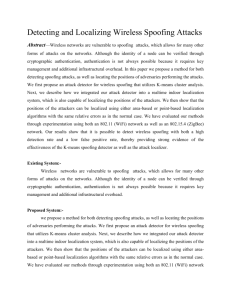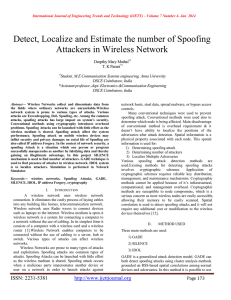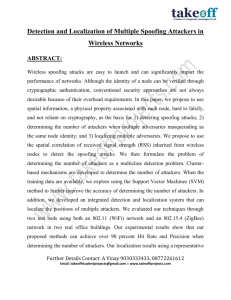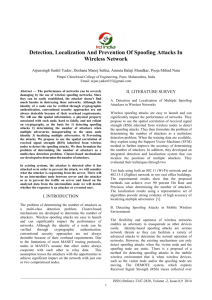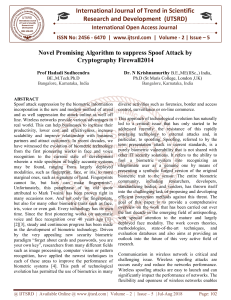Detection and Localization of Multiple Spoofing Attackers in
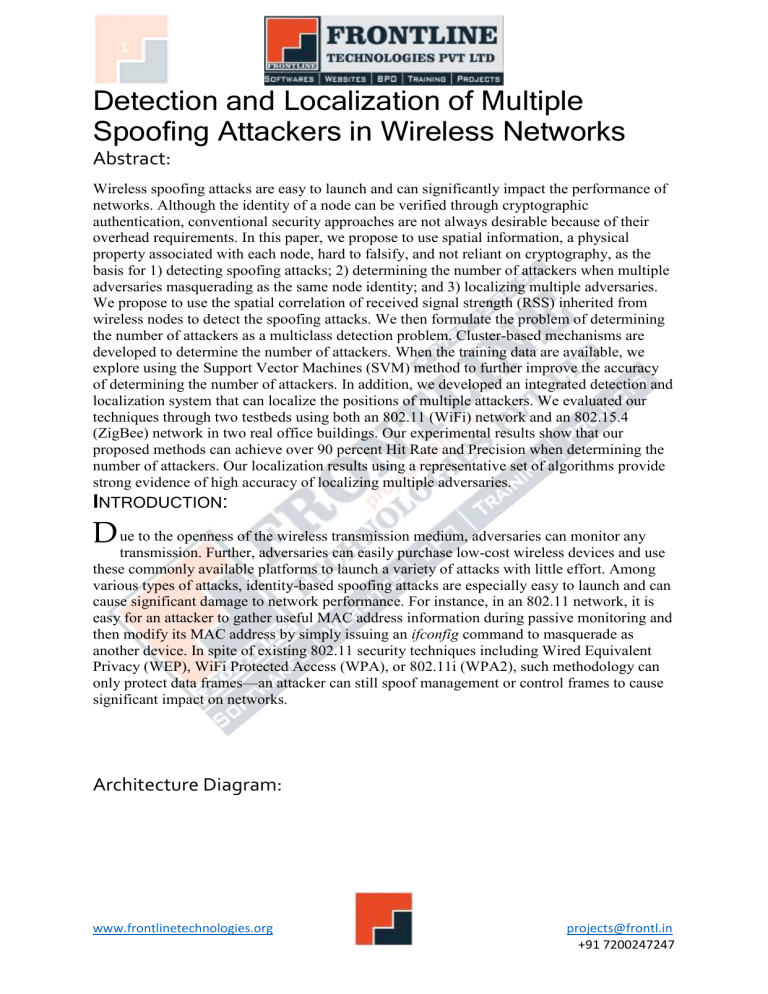
1
Detection and Localization of Multiple
Spoofing Attackers in Wireless Networks
Abstract:
Wireless spoofing attacks are easy to launch and can significantly impact the performance of networks. Although the identity of a node can be verified through cryptographic authentication, conventional security approaches are not always desirable because of their overhead requirements. In this paper, we propose to use spatial information, a physical property associated with each node, hard to falsify, and not reliant on cryptography, as the basis for 1) detecting spoofing attacks; 2) determining the number of attackers when multiple adversaries masquerading as the same node identity; and 3) localizing multiple adversaries.
We propose to use the spatial correlation of received signal strength (RSS) inherited from wireless nodes to detect the spoofing attacks. We then formulate the problem of determining the number of attackers as a multiclass detection problem. Cluster-based mechanisms are developed to determine the number of attackers. When the training data are available, we explore using the Support Vector Machines (SVM) method to further improve the accuracy of determining the number of attackers. In addition, we developed an integrated detection and localization system that can localize the positions of multiple attackers. We evaluated our techniques through two testbeds using both an 802.11 (WiFi) network and an 802.15.4
(ZigBee) network in two real office buildings. Our experimental results show that our proposed methods can achieve over 90 percent Hit Rate and Precision when determining the number of attackers. Our localization results using a representative set of algorithms provide strong evidence of high accuracy of localizing multiple adversaries.
I
NTRODUCTION
:
D ue to the openness of the wireless transmission medium, adversaries can monitor any transmission. Further, adversaries can easily purchase low-cost wireless devices and use these commonly available platforms to launch a variety of attacks with little effort. Among various types of attacks, identity-based spoofing attacks are especially easy to launch and can cause significant damage to network performance. For instance, in an 802.11 network, it is easy for an attacker to gather useful MAC address information during passive monitoring and then modify its MAC address by simply issuing an ifconfig command to masquerade as another device. In spite of existing 802.11 security techniques including Wired Equivalent
Privacy (WEP), WiFi Protected Access (WPA), or 802.11i (WPA2), such methodology can only protect data frames—an attacker can still spoof management or control frames to cause significant impact on networks.
Architecture Diagram:
www.frontlinetechnologies.org
projects@frontl.in
+91 7200247247
2
C ONCLUSION :
In this work, we proposed to use received signal strength- based spatial correlation, a physical property associated with each wireless device that is hard to falsify and not reliant on cryptography as the basis for detecting spoofing attacks in wireless networks. We provided theoretical analysis of using the spatial correlation of RSS inherited from wireless nodes for attack detection. We derived the test statistic based on the cluster analysis of RSS readings.
Our approach can both detect the presence of attacks as well as determine the number of adversaries, spoofing the same node identity, so that we can localize any number of attackers and eliminate them. Determining the number of adversaries is a particularly challenging problem. We developed SILENCE, a mechanism that employs the minimum distance testing in addition to cluster analysis to achieve better accuracy of determining the number of attackers than other methods under study, such as Silhouette Plot and System Evolution, that use cluster analysis alone. Additionally, when the training data are available, we explored using Support Vector Machines-based mechanism to further improve the accuracy of determining the number of attackers present in the system.
References:
4.
5.
1.
J
. Bellardo and S. Savage, "802.11 Denial-of-Service Attacks: Real Vulnerabilities and Practical Solutions," Proc. USENIX Security Symp., pp. 15-28, 2003.
2.
3.
F. Ferreri, M. Bernaschi, and L. Valcamonici, "Access Points Vulnerabilities to Dos
Attacks in 802.11 Networks," Proc. IEEE Wireless Comm. and Networking Conf.,
2004.
D. Faria and D. Cheriton, "Detecting Identity-Based Attacks in Wireless Networks
Using Signalprints," Proc. ACM Workshop Wireless Security (WiSe), Sept. 2006.
Q. Li and W. Trappe, "Relationship-Based Detection of Spoofing- Related
Anomalous Traffic in Ad Hoc Networks," Proc. Ann. IEEE Comm. Soc. on IEEE and
Sensor and Ad Hoc Comm. and Networks (SECON), 2006.
B. Wu, J. Wu, E. Fernandez, and S. Magliveras, "Secure and Efficient Key
Management in Mobile Ad Hoc Networks," Proc. IEEE Int'l Parallel and Distributed
Processing Symp. (IPDPS), 2005. www.frontlinetechnologies.org
projects@frontl.in
+91 7200247247
3
9.
6.
7.
A. Wool, "Lightweight Key Management for IEEE 802.11 Wireless Lans With Key
Refresh and Host Revocation," ACM/Springer Wireless Networks, vol. 11, no. 6, pp.
677-686, 2005.
Y. Sheng, K. Tan, G. Chen, D. Kotz, and A. Campbell, "Detecting 802.11 MAC
Layer Spoofing Using Received Signal Strength," Proc. IEEE INFOCOM, Apr. 2008.
8.
J. Yang, Y. Chen, and W. Trappe, "Detecting Spoofing Attacks in Mobile Wireless
Environments," Proc. Ann. IEEE Comm. Soc. Conf. Sensor, Mesh and Ad Hoc Comm. and Networks (SECON), 2009.
10.
Y. Chen, W. Trappe, and R.P. Martin, "Detecting and Localizing Wireless Spoofing
Attacks," Proc. Ann. IEEE Comm. Soc. Conf. Sensor, Mesh and Ad Hoc Comm. and
Networks (SECON), May 2007.
M. Bohge and W. Trappe, "An Authentication Framework for Hierarchical Ad Hoc
Sensor Networks," Proc. ACM Workshop Wireless Security (WiSe), pp. 79-87, 2003. www.frontlinetechnologies.org
projects@frontl.in
+91 7200247247
